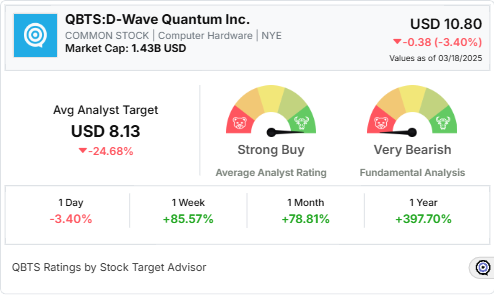D-Wave Quantum (QBTS) Stock: A Comprehensive Investment Analysis

Table of Contents
Understanding D-Wave Quantum's Business Model and Technology
Quantum Annealing Explained
D-Wave Quantum's technology centers around quantum annealing, a type of adiabatic quantum computation designed to solve specific optimization problems. Unlike gate-based quantum computers that operate on qubits using logic gates, quantum annealing leverages the principles of quantum mechanics to find the lowest energy state of a system, representing the optimal solution. This approach is particularly well-suited for complex optimization challenges across various industries. While offering advantages in speed for specific problem types, quantum annealing has limitations compared to the more general-purpose gate-based approach. Key advantages include its current scalability and relatively lower noise levels compared to early gate-based systems. However, it's important to remember that quantum annealing is not a universal quantum computing solution.
D-Wave's Customer Base and Revenue Streams
D-Wave generates revenue through several key streams. These include direct hardware sales of their quantum annealers, providing cloud access to their systems, and licensing their specialized quantum software. They have cultivated a diverse customer base, including major players like Google, Volkswagen, and various research institutions. These clients utilize D-Wave's systems for a wide array of applications, showcasing the versatility of the technology.
- Key Clients and Applications: Google uses D-Wave systems for machine learning optimization, while Volkswagen leverages them for traffic flow optimization. Numerous research institutions utilize the systems for materials science and drug discovery research.
- Revenue Streams: Hardware sales account for a significant portion of revenue, while cloud access and software licensing are growing revenue streams. The relative importance of each stream is subject to change as the company expands its offerings.
- Partnerships and Collaborations: D-Wave actively collaborates with various organizations, further expanding its reach and application of quantum annealing technology. These collaborations enhance both its technological capabilities and market penetration.
Analyzing D-Wave Quantum's Financial Performance and Valuation
Financial Statement Review
Analyzing D-Wave's financial performance requires careful examination of key metrics such as revenue growth, profitability, and debt levels. While revenue growth has been positive, profitability remains a challenge, typical for a company operating in a nascent technological field. Assessing the debt-to-equity ratio provides insights into the company’s financial stability. Detailed analysis of the financial statements—including the income statement, balance sheet, and cash flow statement—is crucial for a comprehensive understanding of the company's financial health. This includes looking at key trends and comparing them to industry benchmarks.
Valuation Metrics
Determining a fair valuation for QBTS requires using various methods, including the Price-to-Sales (P/S) ratio and Discounted Cash Flow (DCF) analysis. The P/S ratio provides a relative valuation compared to competitors, while DCF analysis attempts to estimate the intrinsic value based on projected future cash flows. Given the long-term nature of the quantum computing market and the inherent uncertainties, valuation presents a significant challenge, requiring a degree of speculation about future growth and market adoption.
- Key Financial Figures: Access the latest financial reports from D-Wave Quantum to gather essential data for analysis. Focus on revenue, expenses, net income, and cash flow.
- Competitor Comparison: Compare QBTS's valuation metrics to those of other companies in the quantum computing sector to assess its relative position.
- Future Growth Scenarios: Consider different scenarios for D-Wave's future growth, factoring in technological advancements, market adoption rates, and competitive pressures.
Assessing the Risks and Opportunities of Investing in QBTS
Market Risks
Investing in QBTS carries inherent risks associated with the quantum computing market’s volatility. The technology is still in its early stages, and the market is highly susceptible to technological disruption and changes in investor sentiment. Competition is fierce, with established tech giants and emerging startups vying for market share.
Competitive Landscape
The quantum computing landscape is highly competitive. Major players like IBM Quantum and Google Quantum AI are pursuing different approaches, such as gate-based quantum computing, which may ultimately prove more versatile than D-Wave's annealing approach. Analyzing the strengths and weaknesses of these competitors is vital for assessing D-Wave's long-term prospects.
Long-Term Growth Potential
Despite the risks, the long-term potential of quantum computing is significant. As the technology matures and finds wider application across various industries, the market for quantum computing systems is expected to expand substantially. D-Wave's success will depend on its ability to maintain its technological edge and secure a substantial market share in this rapidly evolving space.
- Main Risks: High volatility, technological disruption, intense competition, and the uncertainty surrounding the market's overall growth rate.
- Key Competitors: IBM, Google, Rigetti, IonQ, and others. Analyze their technologies, strategies, and financial strengths.
- Growth Catalysts: Technological advancements in quantum annealing, strategic partnerships, successful deployment in new applications, and increasing market acceptance.
D-Wave Quantum (QBTS) Stock: A Technical Analysis Perspective (Optional)
(Optional section: If desired, include a brief overview of technical analysis indicators relevant to QBTS stock performance. This could include chart patterns, support and resistance levels, and common trading indicators such as moving averages.)
Conclusion
This analysis of D-Wave Quantum (QBTS) Stock reveals a company at the forefront of a revolutionary technology with significant long-term potential. While D-Wave's unique quantum annealing technology offers advantages for specific optimization problems, the market remains volatile, competitive, and relatively uncertain. The company's financial performance shows early signs of growth, but profitability is yet to be achieved. Investing in QBTS requires a high-risk tolerance, given the inherent uncertainties in the quantum computing market. While the long-term prospects are promising, a cautious approach is advised.
Therefore, we recommend conducting thorough due diligence, including a comprehensive review of D-Wave’s financial statements, competitor analysis, and an assessment of your own risk tolerance before making any investment decisions related to D-Wave Quantum (QBTS) Stock. Remember that investing in emerging technologies always carries a degree of risk, and QBTS stock is no exception.

Featured Posts
-
 Juergen Klopp Transferi Tuem Gelismeler Ve Tahminler
May 21, 2025
Juergen Klopp Transferi Tuem Gelismeler Ve Tahminler
May 21, 2025 -
 The Goldbergs Impact On Television Comedy
May 21, 2025
The Goldbergs Impact On Television Comedy
May 21, 2025 -
 The Rise Of Femicide Causes And Consequences
May 21, 2025
The Rise Of Femicide Causes And Consequences
May 21, 2025 -
 Vanja I Sime Najbolja Kombinacija Iz Gospodina Savrsenog Nove Fotografije
May 21, 2025
Vanja I Sime Najbolja Kombinacija Iz Gospodina Savrsenog Nove Fotografije
May 21, 2025 -
 Todays Nyt Mini Crossword March 16 2025 Answers And Solutions
May 21, 2025
Todays Nyt Mini Crossword March 16 2025 Answers And Solutions
May 21, 2025
